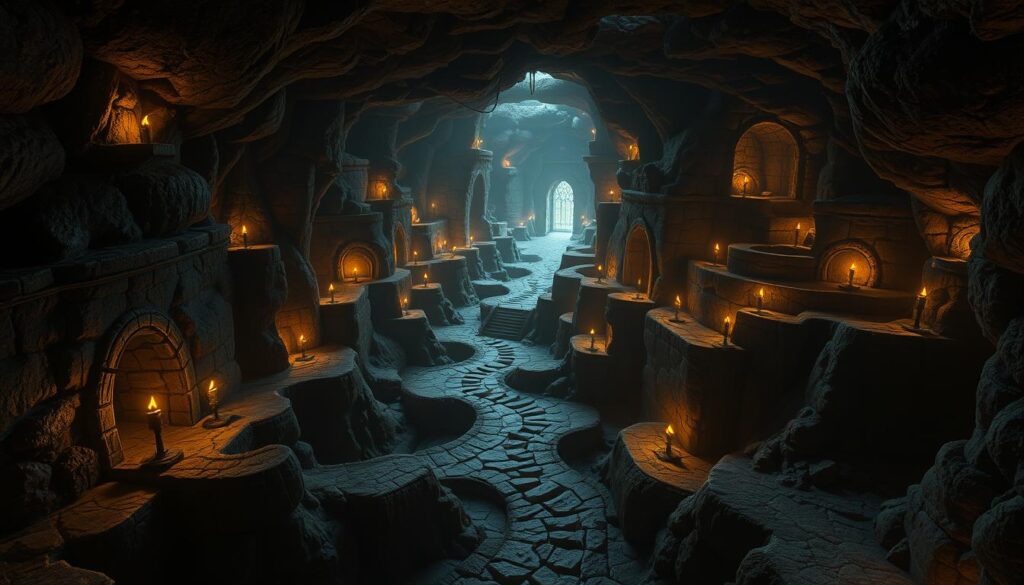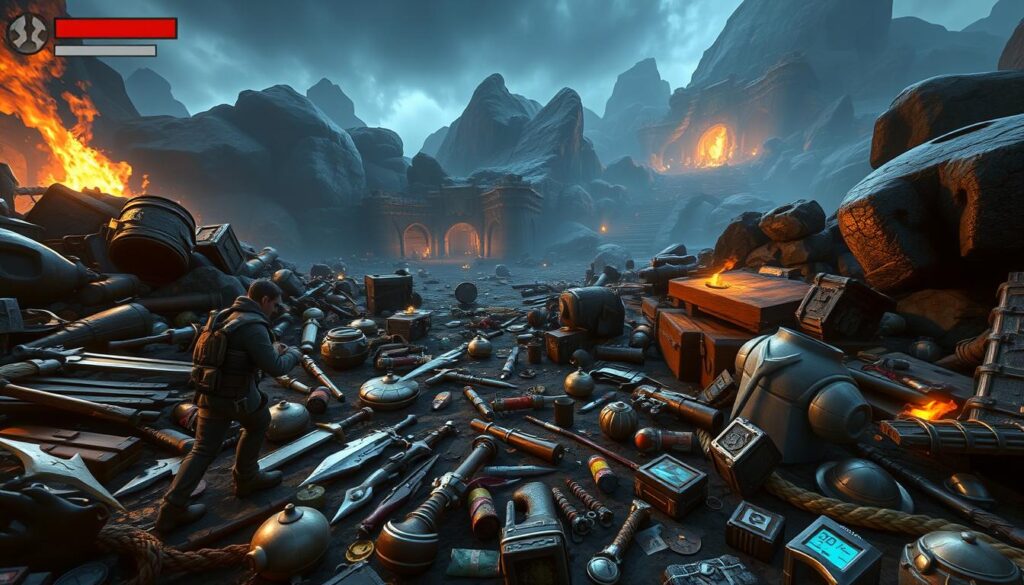Ever wondered why some mobile survival games keep you hooked, while others lose your interest quickly? The answer often lies in loot balancing. In dynamic procedural dungeons, where everything changes, loot distribution is key to a great player experience.
This article will look into the importance of smart loot balancing for mobile survival games. By balancing challenges and rewards, developers can make games that keep players coming back. You’ll learn how these strategies affect player choices and satisfaction in dynamic dungeons.
Understanding Dynamic Procedural Dungeons
Dynamic procedural dungeons are a new way to design games. They create environments on the fly, based on how players play. This makes each game session unique and fun.
Developers work hard to make these dungeons better. They want players to feel excited and curious. When players face new challenges, they get more into the game.
Games like Minecraft and Spelunky are great examples. They use procedural generation to keep players interested. The changing environments and challenges make the game exciting to play over and over.

The Role of Loot in Mobile Survival Games
Loot mechanics are key in mobile survival games, making the game more exciting. Players look for rewards like weapons, resources, and crafting materials. These are vital for survival and moving forward in the game.
How loot is given out affects how much players want to play. It makes them explore and get involved in the game world. This keeps them coming back for more.

Having different loot mechanics makes games more engaging. It gives players real rewards, making them think about how to use them best. Getting new items or resources adds excitement, keeping players eager to play more.
Importance of Loot Balancing
Loot balancing is key in mobile survival games. It affects the game’s balance, keeping players interested and happy. A good loot system rewards players fairly, keeping the game fun and challenging.
Too many rewards can make finding them boring. On the other hand, not enough rewards can upset players. Finding the perfect balance keeps players excited and playing more.
Good loot balancing makes the game more enjoyable. It makes players want to keep playing, try new things, and join the game’s community. This helps keep players coming back for more.
Challenges in Loot Balancing for Procedural Dungeons
Game developers face big challenges when making loot systems for procedural dungeons. The main problem is the random nature of procedural content. This randomness can cause some players to get too much loot, while others get too little.
Keeping the game fair for all players is another big issue. It’s important to make sure everyone has a fair shot at winning. Designers struggle to balance loot with the dungeon’s difficulty. If rewards don’t match the challenges, players might lose interest.
To solve these problems, developers need to find new ways to make loot systems fair and fun. By understanding and fixing the issues with procedural content, they can make players happier.
Common Loot Balancing Techniques
Effective loot balancing is key to keeping players engaged in mobile survival games. Developers use different techniques to make the game more rewarding. One way is to adjust item rarity, so players find a variety of items as they play.
This keeps the game interesting and gives players a sense of accomplishment when they find rare items.
Another strategy is to design adaptive systems. These systems watch how players play and change the items available based on their actions. This makes the game feel more personal and unique to each player.
Adding feedback loops to the loot balancing process also boosts player satisfaction. Developers use player data to make changes to the loot distribution. This ensures the game meets player expectations and challenges.
This ongoing dialogue between players and the game leads to continuous improvement and adaptation.
Intelligent Loot Balancing in Procedural Dungeons
Intelligent loot balancing changes how players enjoy procedural dungeons in mobile survival games. It uses data analysis to make loot fit what players like and do. This way, developers can make sure players stay interested and keep playing.
Advanced algorithms are key to this balancing. They look at what players have done before, what they struggle with, and how far they’ve come. This helps create a loot experience that changes as players play, making the game more fun and satisfying.
Adding intelligent loot balancing makes games more exciting. It turns procedural dungeons into places where finding treasures is as thrilling as the journey. This mix of data and loot makes each quest special and worth the effort.
Implementing Random Number Generation Techniques
Random number generation is key in making loot distribution in mobile survival games more exciting. By using different RNG techniques, developers can make each player’s experience unique. This leads to unexpected rewards that keep players engaged.
Integrating RNG into procedural generation systems helps create a balanced loot ecosystem. Game designers can set up various loot tiers and categories. This ensures players get rewards that match their progress and achievements. The unpredictability adds depth and keeps players coming back for more.
Thoughtful use of random number generation prevents repetitive gameplay. Developers can control how often and how rare loot drops are. This balance makes the game rewarding and challenging. Players are motivated to explore every part of the procedurally generated dungeons.
Procedural Content Generation Algorithms
In the world of dungeon design, procedural content generation is key. It helps create dynamic and engaging gameplay. Algorithms like Perlin Noise make smooth, natural patterns for terrain. This ensures each dungeon is unique.
Cellular automata is also important. It uses simple rules to create complex designs. This makes dungeons challenging and immersive. Knowing these algorithms helps game creators craft exciting adventures.
Choosing the right algorithm affects how players feel. It ensures rewards match the challenges they face. This makes each playthrough rewarding and balanced. Effective procedural content generation keeps players coming back for more.
The Interaction of Difficulty and Loot Distribution
Balancing difficulty and loot distribution is key in mobile survival games. As players get better, the challenges should grow too. This keeps the game exciting and prevents players from getting bored or stuck.
Good loot distribution is vital for a balanced game. It decides how rewards match up with the challenges. This balance is what keeps players coming back for more.
Looking at player experiences shows how these elements work together. A great loot system makes players feel good about their wins. This makes them want to play more.
Developers need to watch both difficulty and loot closely. This balance is what keeps the game fun and rewarding.
Many top mobile survival games use special metrics to check loot and difficulty. For example, as players face harder levels, the rewards should be better and more exciting. This makes the game more than just routine, keeping players happy and engaged.
Case Studies: Successful Loot Systems in Mobile Survival Games
Looking at real examples helps us understand good loot systems in mobile games. Two examples show how new ideas can keep players coming back and playing more.
*Manaballs*, a hit mobile survival game, is known for its exciting loot. Players love finding rare items that make their game better. The game has a system where rare items lead to more exploration, keeping players interested.
*Last Shelter: Survival* uses a smart loot system that changes based on how players do. It gives better rewards to those who play more and do better. This makes players feel they’re getting something special for their effort, keeping them playing.
| Game | Loot System Type | Key Features | Impact on Player Retention |
|---|---|---|---|
| Manaballs | Dynamic Loot Distribution | Tiered item rarity, strategic gameplay mechanics | High player engagement, encourages exploration |
| Last Shelter: Survival | Adaptive Loot System | Performance-based rewards, tailored experiences | Increased sense of achievement, sustained gameplay motivation |
These examples show how good loot systems can make mobile games better. By learning from these successes, game makers can make their games even more fun. Good loot systems are key to keeping players happy and playing longer.
Player Feedback and Its Role in Loot Balancing
Getting player feedback is key for balancing loot in dynamic dungeons. By listening to players, developers can understand what they like and what they don’t. This helps make the game more enjoyable for everyone.
Using surveys, in-game data, and community talks can give developers a lot of useful information. This info helps them make the game better, ensuring loot is fair and fun. By making these changes, players get a more satisfying experience.
Using player feedback to improve loot balancing makes the game better over time. It helps designers create a game that players love. This not only makes players happier but also brings the gaming community closer together.
Monitoring Player Engagement and Experience
Keeping an eye on how players engage is key in game design, especially in dynamic dungeons. Seeing how players react to loot can tell us a lot about what they enjoy. Tools help track player actions in real-time, giving us a better look at what they like and what they find tough.
Player analytics are a big help here. By looking at how players interact with loot and rewards, we can spot trends. This data helps us see what needs tweaking to keep players engaged and happy.
With these insights, we can make changes to improve the game. We might tweak loot rarity or change how rewards are given out. By paying attention to player feedback, we can fix issues fast and keep the game fun.
| Monitoring Tool | Key Features | Benefits |
|---|---|---|
| User Behavior Tracking | Records player interactions and actions | Identifies popular gameplay elements |
| Heatmaps | Visual representation of player movement | Pinpoints areas of high and low engagement |
| Surveys and Feedback Forms | Collects direct player input | Gathers qualitative data on experiences |
| Analytics Dashboards | Real-time data visualization | Facilitates quick decision-making |
Iterative Design: Adjusting Loot Balancing Over Time
Iterative design is key to improving loot balancing in mobile survival games. It means making changes based on what players do and say. This way, developers can fix loot problems and keep players playing.
Looking at data is important in this process. It shows what players like and how they play. This helps developers make loot better and more fun. It keeps the game exciting for everyone.
Using iterative design, developers can fix problems fast and make the game better. They keep updating and improving to keep players interested. This makes the game a fun and rewarding place to be.
The Future of Loot Balancing in Mobile Games
Mobile gaming is growing fast, and loot balancing is key. Developers are exploring new tech to improve games. They’re looking at AI to make loot more personal and exciting.
AI can make loot fit each player’s style better. This means games will feel more like they’re made just for you. It’s a big step towards making games more enjoyable.
Keeping players interested is crucial. They want rewards that show their hard work. AI can help make loot systems that change based on how you play.
This customization will make games more fun and rewarding. It’s a big win for players.
Looking ahead, we’ll see more use of analytics and feedback in games. This will help designers make better loot systems. It will keep players coming back for more.
In short, the future of loot balancing in mobile games looks bright. We’re moving towards AI-driven systems that make games more rewarding. It’s an exciting time for gamers and developers alike.
Conclusion
Loot balancing in mobile survival games is key to keeping players engaged and happy. It uses smart strategies and dynamic dungeons to create fun experiences. This approach makes games more exciting and keeps players coming back for more.
As mobile gaming grows, so will the need for better loot systems. A well-designed loot system can turn a basic game into an epic adventure. With ongoing improvements, we can expect even more exciting games that reward players well.
The link between loot and keeping players is clear. To keep games fresh, we need to keep working on loot balancing. By focusing on these techniques, the future of mobile games looks bright and full of possibilities.
FAQ
What are dynamic procedural dungeons?
Dynamic procedural dungeons are special areas in mobile survival games. They change based on how players interact with them. Each time you play, you get a new layout, enemies, and treasures.
How does loot balancing affect player satisfaction?
Loot balancing is key to keeping players happy. It makes sure rewards match the game’s challenges. This balance keeps players coming back for more.
What challenges do developers face when balancing loot?
Developers face many hurdles, like making loot fair and keeping players motivated. They must balance these to create a fun game for everyone.
What common techniques are used for loot balancing?
To balance loot, developers use several methods. They adjust item rarity and create systems that adapt to player actions. They also use feedback to improve the loot experience.
How is intelligent loot balancing implemented in games?
Intelligent loot balancing uses data and algorithms to understand player behavior. This lets developers adjust loot in real-time, making the game more engaging.
What is the role of RNG in loot systems?
RNG, or random number generation, is crucial for loot systems. It adds variety and keeps players interested by providing surprises.
What algorithms are commonly used for procedural content generation?
Developers often use Perlin Noise and cellular automata to create dynamic dungeons. The right algorithm can greatly impact the loot and player experience.
How can difficulty be balanced alongside loot distribution?
Balancing difficulty and loot means making sure rewards match challenges. As players progress, the game should offer new challenges without making it too hard.
What are some successful examples of loot systems in mobile survival games?
Games like *Manaballs* have great loot systems. They keep players interested and motivated with rewarding experiences.
How can player feedback improve loot systems?
Feedback from players is essential. Surveys, analytics, and community talks help developers make loot systems better. This ensures the game stays enjoyable for everyone.
What tools are used to monitor player engagement?
Analytics tools help track player behavior and preferences. This information guides game changes to keep players engaged over time.
Why is iterative design important for loot balancing?
Iterative design means making continuous improvements based on data and feedback. It helps ensure the loot experience meets player expectations and keeps them interested.
What future trends are expected in loot balancing?
AI and data analytics will likely improve loot systems in mobile games. These advancements could lead to more personalized and engaging gameplay experiences.




